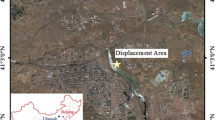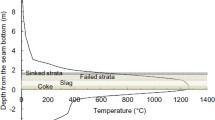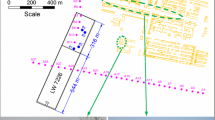Abstract
Underground coal gasification (UCG) is an important part of the low-carbon green coal mining technology system. With the implementation of the carbon peaking and carbon neutralization and the maturity of UCG, UCG will inevitably perform large-scale and industrialized production, which will certainly cause some issues such as serious waste of UCG sites caused by large-scale surface residual subsidence and poor foundation of fractured rocks. The key to the reuse of the surface site after UCG is to ensure that the surface residual subsidence does not exceed the design index of the building (structure). However, there is still a lack of methods for predicting residual subsidence on the surface of UCG. Under such background, combined with the characteristics of the UCG process, this paper analyzed the mechanism of the surface residual subsidence after UCG, and concluded that the root resource of the surface residual subsidence after UCG was the stripping and yielding of the hyperbolic coal pillars. Next, a calculation model of the maximum stripping width and yielding zone width of the “hyperbolic” coal pillar for UCG was established by the theoretical analysis method, and a method for predicting the surface residual subsidence with the consideration of coal pillar stripping and yielding was proposed and applied to Ulanqab UCG test site. The research findings have important theoretical and practical significance for the UCG site stability evaluation and land resource reuse.








Similar content being viewed by others
References
Al-Ghussain L (2019) Global warming: review on driving forces and mitigation. Environ Prog Sustainable Energy 38(1):13–21
Ariyoshi D, Takeda S, Kosuge K, Mizuno M, Kato K (2016) Development of high-efficiency coal gasification technology. Springer, Singapore, pp 617–619
Bhutto AW, Bazmi AA, Zahedi G (2013) Underground coal gasification: from fundamentals to applications. Prog Energy Combust Sci 39(1):189–214
Chen D, Chen H, Zhang W, Cao C, Zhu K, Yuan X, Du Y (2020) Characteristics of the residual surface deformation of multiple abandoned mined-out areas based on a field investigation and SBAS-InSAR: a case study in Jilin China. Remote Sensing 12(22):3752
Cui X, Zhao Y, Wang G, Zhang B, Li C (2020) Calculation of residual surface subsidence above abandoned longwall coal mining. Sustainability 12(4):1528
Deficiency:assuming that the void will be absoluted compressed and some calculating Eq can be optimized. Journal of Cleaner Production 279.
Friedmann SJ, Upadhye R, Kong FM (2008) Prospects for underground coal gasification in carbon-constrained, 9th International Conference on Greenhouse Gas Control Technologies. Washington, DC. Energy Proc. 1:4551–4557
Guang-li G, Ka-zhong D, Zhi-xiang T, Feng-chun L (2002) Study on the prediction method of ground residual subsidence in the deep abandoned longwall goaf and its application. J Liaoning Tech Univ (natural Science) 01:1–3
Guo QB, Meng XR, Li YM, Lv X, Liu C (2021) A prediction model for the surface residual subsidence in an abandoned goaf for sustainable development of resource-exhausted cities. Deficiency:assuming that the void will be absoluted compressed and some calculating Eq can be optimized. J Clean Prod. https://doi.org/10.1016/j.jclepro.2020.123803
Hargroves K, Desha C, von Weisaecker E (2016) Introducing carbon structural adjustment: energy productivity and decarbonization of the global economy. Wiley Interdiscip Rev-Energy Environ 5(1):57–67
Huang CF, Li Q, Tian SG (2020) Research on prediction of residual deformation in goaf of steeply inclined extra-thick coal seam. PLoS ONE 15(10):e0240428
Jian Y, Yu-feng G, Yong-feng C, Xian-long L (2009) Passive earth pressure of inclined retaining walls under seismic condition. Chin J Geotech Eng 31(09):1391–1397
Johnstone P, Rogge KS, Kivimaa P, Fratini CF, Primmer E (2021) Exploring the re-emergence of industrial policy: Perceptions regarding low-carbon energy transitions in Germany, the United Kingdom and Denmark. Energy Res Soc Sci 74:101889
Ka-zhong D, Zhi-xiang T, Hong-zhen Z, Hong-dong F, Li-ya Z (2012) Research on calculating method of residual subsidence of longwall goaf. J China Coal Soc 37(0253–9993):1601–1605
Le Quéré C, Capstick S, Corner A, Cutting D, Johnson M, Minns A, Schroeder H, Walker-Springett K, Whitmarsh L, Wood R (2015) Towards a culture of low-carbon research for the 21st Century. University of East Anglia, Tyndall Centre
Li HZ, Guo GL, Zha JF, He Y, Wang ZY, Qin SY (2017) Stability evaluation method for hyperbolic coal pillars under the coupling effects of high temperature and ground stress. Environ Earth Sci. https://doi.org/10.1007/s12665-017-7048-0
Li PX, Yan LL, Yao DH (2019) Study of tunnel damage caused by underground mining deformation: calculation, analysis, and reinforcement. Adv Civil Eng. https://doi.org/10.1155/2019/4865161
Luan YZ, Dong Y, Ma Y, Weng L (2020) Surface and new building deformation analysis of deep well strip mining. Adv Mater Sci Eng 2020:8727956. https://doi.org/10.1155/2020/8727956
Prabu V (2015) Integration of in-situ CO2-oxy coal gasification with advanced power generating systems performing in a chemical looping approach of clean combustion. Appl Energy 140:1–13
Qin L, Kirikkaleli D, Hou Y, Miao X, Tufail M (2021) Carbon neutrality target for G7 economies: examining the role of environmental policy, green innovation and composite risk index. J Environ Manag 295:113119
Salamon BJ, Madden MU (1998) Life and design of bord-and-pillar workings affected by pillar scaling. J South Afr Inst Min Metall 98(3):135–145
Slamersak A, Kallis G, O’Neill DW (2022) Energy requirements and carbon emissions for a low-carbon energy transition. Nat Commun. https://doi.org/10.1038/s41467-022-33976-5
Sovacool BK (2022) A perspective on treaties, maximum wages, and carbon currencies: innovative policy instruments for global decarbonization. Energy Policy 160:112702
Suzuki M, Kanie N, Iguchi M (2016) New approaches for transitions to low fossil carbon societies: promoting opportunities for effective development, diffusion and implementation of technologies, policies and strategies. J Clean Prod 128:1–5
Van der Merwe JN (2003) Predicting coal pillar life in South Africa. J S Afr Inst Min Metall 103(5):293–301
van der Merwe JN, Mathey M (2013) Update of coal pillar database for South African coal mining. J South Afr Inst Min Metall 113(11):825–840
Walker LK (2014) Underground coal gasification: issues in commercialisation. Proc Inst Civ Eng Energy 167(4):188–195
Wilson AH (1983) The stability of underground workings in the soft rocks of the coal measures. Int J Min Eng 1(2):91–187
Wu XF, Xu YC, Lou YT, Chen Y (2018) Low carbon transition in a distributed energy system regulated by localized energy markets. Energy Policy 122:474–485
Xie J, Xin L, Hu XM, Cheng WM, Liu WT, Wang ZG (2020) Technical application of safety and cleaner production technology by underground coal gasification in China. J Clean Prod 250:119487
Yang Y, Kazhong D, Hongdong F (2017) Long-term stability evaluation and coal pillar design methods for strip mining. J China Coal Soc 42(12):3089–3095
Yu Y, Deng KZ, Luo Y, Chen SE, Zhuang HF (2018) An improved method for long-term stability evaluation of strip mining and pillar design. Int J Rock Mech Min 107:25–30
Zheng M, Deng K, Fan H, Du S (2018) Monitoring and analysis of surface deformation in mining area based on InSAR and GRACE. Remote Sens 10(9):1392
Zheng M et al (2018) Monitoring and analysis of surface deformation in mining area based on InSAR and GRACE. Remote Sens 10(9):1392
Acknowledgements
This work was funded by the National Natural Science Foundation of China (42174048), Natural Science Foundation of Jiangsu Province (BK20220158), Scientific Research Project of Jiangsu Bureau of Geological and Mineral Exploration (2021KY08), and the CNPC Innovation Found (2023DQ02-0108).
Author information
Authors and Affiliations
Contributions
Conceptualization: CT and HL; methodology: CT and HL; validation: WL and FC; formal analysis: XZ; investigation: CL and GD; data curation: YY; writing—original draft preparation: HL and CT; writing—review and editing: HL and CT; visualization: XZ; supervision: GG and JZ; project administration: GG and JZ; funding acquisition: HL. All authors reviewed the manuscript.
Corresponding author
Ethics declarations
Conflict of interest
The authors declare no conflict of interest.
Additional information
Publisher's Note
Springer Nature remains neutral with regard to jurisdictional claims in published maps and institutional affiliations.
Rights and permissions
Springer Nature or its licensor (e.g. a society or other partner) holds exclusive rights to this article under a publishing agreement with the author(s) or other rightsholder(s); author self-archiving of the accepted manuscript version of this article is solely governed by the terms of such publishing agreement and applicable law.
About this article
Cite this article
Tang, C., Li, H., Guo, G. et al. Prediction method of surface residual subsidence for land resource reuse after low-carbon underground coal gasification. Environ Earth Sci 82, 490 (2023). https://doi.org/10.1007/s12665-023-11177-7
Received:
Accepted:
Published:
DOI: https://doi.org/10.1007/s12665-023-11177-7




